A Green, Simple and Facile Way to Synthesize Silver Nanoparticles Using Soluble Starch. pH Studies and Antimicrobial Applications
Abstract
:1. Introduction
2. Materials and Methods
2.1. Ag-NPs Synthesis and Characterization
2.2. Microbiological Activity
3. Results and Discussion
3.1. Ag-NPs Synthesis and Characterization
- (a)
- Ag-NPs synthesis
- (b)
- UV-VIS spectroscopy analysis
- (c)
- Scanning electron microscopy, SEM, and studies
- (d)
- Energy-dispersive X-ray spectroscopy analysis, EDX
- (e)
- Fourier transform infrared spectroscopy analysis, FT-IR
- (f)
- Zeta potential of Ag-NPs measurement
3.2. Microbiological Activity
4. Conclusions
Author Contributions
Funding
Institutional Review Board Statement
Informed Consent Statement
Data Availability Statement
Conflicts of Interest
References
- El-Rafie, M.H.; Ahmed, H.B.; Zahran, M.K. Facile Precursor for Synthesis of Silver Nanoparticles Using Alkali Treated Maize Starch. Int. Sch. Res. Not. 2014, 2014, 1–12. [Google Scholar] [CrossRef] [Green Version]
- Gao, X.H.; Wei, L.Q.; Wang, J.; Xu, B.S. Green Synthesis of Starch-Stabilized Silver Nanoparticles and their Antibacterial Properties. Adv. Mater. Res. 2011, 236–238, 1945–1948. [Google Scholar] [CrossRef]
- Jung, J.; Raghavendra, G.M.; Kim, D.; Seo, J. One-step synthesis of starch-silver nanoparticle solution and its application to antibacterial paper coating. Int. J. Biol. Macromol. 2018, 107, 2285–2290. [Google Scholar] [CrossRef] [PubMed]
- Raji, V.; Chakraborty, M.; Parikh, P.A. Synthesis of Starch-Stabilized Silver Nanoparticles and Their Antimicrobial Activity. Part. Sci. Technol. 2012, 30, 565–577. [Google Scholar] [CrossRef]
- El-Nour, K.M.A.; Eftaiha, A.; Al-Warthan, A.; Ammar, R.A. Synthesis and applications of silver nanoparticles. Arab. J. Chem. 2010, 3, 135–140. [Google Scholar] [CrossRef] [Green Version]
- Tran, Q.H.; Nguyen, V.Q.; Le, A.-T. Silver nanoparticles: Synthesis, properties, toxicology, applications and perspectives. Adv. Nat. Sci. Nanosci. Nanotechnol. 2013, 4, 033001. [Google Scholar] [CrossRef] [Green Version]
- Xing, M.M.; Ge, L.; Wang, M.; Li, Q.; Li, X.; Ouyang, J. Nanosilver particles in medical applications: Synthesis, performance, and toxicity. Int. J. Nanomed. 2014, 9, 2399–2407. [Google Scholar] [CrossRef] [Green Version]
- Pinto, R.J.B.; Nasirpour, M.; Carrola, J.; Oliveira, H.; Freire, C.S.R.; Duarte, I.F. Chapter 9—Antimicrobial properties and therapeutic applications of silver nanoparticles and nanocomposites. In Antimicrobial Nanoarchitectonics; Grumezescu, A.M., Ed.; Elsevier: Amsterdam, The Netherlands, 2017; pp. 223–259. [Google Scholar]
- Xia, Y.; Xiong, Y.; Lim, B.; Skrabalak, S.E. Shape-Controlled Synthesis of Metal Nanocrystals: Simple Chemistry Meets Complex Physics? Angew. Chem. Int. Ed. 2009, 48, 60–103. [Google Scholar] [CrossRef]
- Wei, L.; Lu, J.; Xu, H.; Patel, A.; Chen, Z.-S.; Chen, G. Silver nanoparticles: Synthesis, properties, and therapeutic applications. Drug Discov. Today 2015, 20, 595–601. [Google Scholar] [CrossRef] [Green Version]
- Khan, Z.H.; Tarek, F.K.; Nuzat, M.; Momin, M.A.; Hasan, M.R. Rapid Biological Synthesis of Silver Nanoparticles from Ocimum sanctum and Their Characterization. J. Nanosci. 2017, 2017, 1–6. [Google Scholar] [CrossRef] [Green Version]
- Kumar, B.; Smita, K.; Cumbal, L.; Debut, A.; Pathak, R.N. Sonochemical Synthesis of Silver Nanoparticles Using Starch: A Comparison. Bioinorg. Chem. Appl. 2014, 2014, 1–8. [Google Scholar] [CrossRef]
- Qin, Y.; Ji, X.; Jing, J.; Liu, H.; Wu, H.; Yang, W. Size control over spherical silver nanoparticles by ascorbic acid reduction. Colloids Surf. A Physicochem. Eng. Asp. 2010, 372, 172–176. [Google Scholar] [CrossRef]
- Singh, R.K.; Panigrahi, B.; Mishra, S.; Das, B.; Jayabalan, R.; Parhi, P.; Mandal, D. pH triggered green synthesized silver nanoparticles toward selective colorimetric detection of kanamycin and hazardous sulfide ions. J. Mol. Liq. 2018, 269, 269–277. [Google Scholar] [CrossRef]
- Khodashenas, B.; Ghorbani, H.R. Synthesis of silver nanoparticles with different shapes. Arab. J. Chem. 2019, 12, 1823–1838. [Google Scholar] [CrossRef] [Green Version]
- Fayaz, A.M.; Balaji, K.; Girilal, M.; Yadav, R.; Kalaichelvan, P.T.; Venketesan, R. Biogenic synthesis of silver nanoparticles and their synergistic effect with antibiotics: A study against gram-positive and gram-negative bacteria. Nanomed. Nanotechnol. Biol. Med. 2010, 6, 103–109. [Google Scholar] [CrossRef] [PubMed]
- Pandian, A.M.K.; Karthikeyan, C.; Rajasimman, M.; Dinesh, M. Synthesis of silver nanoparticle and its application. Ecotoxicol. Environ. Saf. 2015, 121, 211–217. [Google Scholar] [CrossRef]
- Vasileva, P.; Donkova, B.; Karadjova, I.; Dushkin, C. Synthesis of starch-stabilized silver nanoparticles and their application as a surface plasmon resonance-based sensor of hydrogen peroxide. Colloids Surf. A Physicochem. Eng. Asp. 2011, 382, 203–210. [Google Scholar] [CrossRef]
- Beyene, H.D.; Werkneh, A.A.; Bezabh, H.K.; Ambaye, T.G. Synthesis paradigm and applications of silver nanoparticles (AgNPs), a review. Sustain. Mater. Technol. 2017, 13, 18–23. [Google Scholar] [CrossRef]
- Mikac, L.; Ivanda, M.; Gotić, M.; Mihelj, T.; Horvat, L. Synthesis and characterization of silver colloidal nanoparticles with different coatings for SERS application. J. Nanoparticle Res. 2014, 16, 1–13. [Google Scholar] [CrossRef]
- Mao, C.; Wang, F.; Cao, B. Controlling Nanostructures of Mesoporous Silica Fibers by Supramolecular Assembly of Genetically Modifiable Bacteriophages. Angew. Chem. Int. Ed. 2012, 51, 6411–6415. [Google Scholar] [CrossRef] [Green Version]
- Vandecandelaere, N.; Rey, C.; Drouet, C. Biomimetic apatite-based biomaterials: On the critical impact of synthesis and post-synthesis parameters. J. Mater. Sci. Mater. Med. 2012, 23, 2593–2606. [Google Scholar] [CrossRef] [Green Version]
- Cheviron, P.; Gouanvé, F.; Espuche, E. Green synthesis of colloid silver nanoparticles and resulting biodegradable starch/silver nanocomposites. Carbohydr. Polym. 2014, 108, 291–298. [Google Scholar] [CrossRef]
- Raveendran, P.; Fu, J.; Wallen, S. A simple and “green” method for the synthesis of Au, Ag, and Au–Ag alloy nanoparticles. Green Chem. 2005, 8, 34–38. [Google Scholar] [CrossRef]
- Hussain, S.T.; Iqbal, M.; Mazhar, M. Size control synthesis of starch capped-gold nanoparticles. J. Nanoparticle Res. 2009, 11, 1383–1391. [Google Scholar] [CrossRef]
- Tongsakul, D.; Wongravee, K.; Thammacharoen, C.; Ekgasit, S. Enhancement of the reduction efficiency of soluble starch for platinum nanoparticles synthesis. Carbohydr. Res. 2012, 357, 90–97. [Google Scholar] [CrossRef]
- Valodkar, M.; Rathore, P.S.; Jadeja, R.; Thounaojam, M.; Devkar, R.V.; Thakore, S. Cytotoxicity evaluation and antimicrobial studies of starch capped water soluble copper nanoparticles. J. Hazard. Mater. 2012, 201–202, 244–249. [Google Scholar] [CrossRef] [PubMed]
- Taurozzi, J.; Hackley, V.; Wiesner, M. Preparation of Nanoparticle Dispersions from Powdered Material Using Ultrasonic Disruption—Version 1.1; Center for the Environmental Implications of Nanotechnology: Durham, NC, USA, 2012. [Google Scholar]
- Le Ouay, B.; Stellacci, F. Antibacterial activity of silver nanoparticles: A surface science insight. Nano Today 2015, 10, 339–354. [Google Scholar] [CrossRef] [Green Version]
- Ahmad, A.; Wei, Y.; Syed, F.; Tahir, K.; Rehman, A.U.; Khan, A.; Ullah, S.; Yuan, Q. The effects of bacteria-nanoparticles interface on the antibacterial activity of green synthesized silver nanoparticles. Microb. Pathog. 2017, 102, 133–142. [Google Scholar] [CrossRef] [PubMed]
- Khan, S.U.; Saleh, T.A.; Wahab, A.; Khan, M.H.U.; Khan, D.; Khan, W.U.; Rahim, A.; Kamal, S.; Khan, F.U.; Fahad, S. Nanosilver: New ageless and versatile biomedical therapeutic scaffold. Int. J. Nanomed. 2018, 13, 733–762. [Google Scholar] [CrossRef] [Green Version]
- Pascu, B.; Ardean, C.; Davidescu, C.M.; Negrea, A.; Ciopec, M.; Duțeanu, N.; Negrea, P.; Rusu, G. Negrea Modified Chitosan for Silver Recovery—Kinetics, Thermodynamic, and Equilibrium Studies. Mater. 2020, 13, 657. [Google Scholar] [CrossRef] [Green Version]
- Pascu, B.; Negrea, A.; Ciopec, M.; Davidescu, C.M.; Negrea, P.; Gherman, V.; Duteanu, N. New Generation of Antibacterial Products Based on Colloidal Silver. Materials 2020, 13, 1578. [Google Scholar] [CrossRef] [PubMed] [Green Version]
- Jonidi Jafari, A.; Rostami, R.; Ghainy, G. Advance in bioaerosol removal technologies; a review. Iran. J. Health Saf. Environ. 2018, 5, 1007–1016. [Google Scholar]
- Paladini, F.; Pollini, M. Antimicrobial Silver Nanoparticles for Wound Healing Application: Progress and Future Trends. Materials 2019, 12, 2540. [Google Scholar] [CrossRef] [Green Version]
- Lu, L.; Sun, R.W.-Y.; Chen, R.; Hui, C.-K.; Ho, C.-M.; Luk, J.M.; Lau, G.K.K.; Che, C.-M. Silver nanoparticles inhibit hepatitis B virus replication. Antivir. Ther. 2008, 13, 253–262. [Google Scholar]
- Bapat, R.A.; Chaubal, T.V.; Joshi, C.P.; Bapat, P.R.; Choudhury, H.; Pandey, M.; Gorain, B.; Kesharwani, P. An overview of application of silver nanoparticles for biomaterials in dentistry. Mater. Sci. Eng. C 2018, 91, 881–898. [Google Scholar] [CrossRef] [PubMed]
- Dini, L.; Panzarini, E.; Serra, A.; Buccolieri, A.; Manno, D. Synthesis and in vitro Cytotoxicity of Glycans-Capped Silver Nanoparticles. Nanomater. Nanotechnol. 2011, 1, 1. [Google Scholar] [CrossRef]
- CLSI. Performance Standards for Antimicrobial Susceptibility Testing, 30th ed.; CLSI supplement M100; Clinical and Laboratory Standards Institute: Wayne, PA, USA, 2020. [Google Scholar]
- Mikac, L.; Ivanda, M.; Gotić, M.; Mihelj, I.T. Synthesis and Characterization of silver colloidal nanoparticles and their application in surface enhanced Raman spectroscopy. In Proceedings of the 37th International Convention on Information and Communication Technology, Electronics and Microelectronics (MIPRO), Opatija, Croatia, 26–30 May 2014. [Google Scholar]
- Gudikandula, K.; Maringanti, S.C. Synthesis of silver nanoparticles by chemical and biological methods and their antimicrobial properties. J. Exp. Nanosci. 2016, 11, 714–721. [Google Scholar] [CrossRef]
- Vega-Baudrit, J.; Gamboa, S.M.; Rojas, E.R.; Martinez, V.V. Synthesis and characterization of silver nanoparticles and their application as an antibacterial agent. Int. J. Biosens. Bioelectron. 2019, 5, 166–173. [Google Scholar] [CrossRef] [Green Version]
- Buccolieri, A.; Serra, A.; Giancane, G.; Manno, D. Colloidal solution of silver nanoparticles for label-free colorimetric sensing of ammonia in aqueous solutions. Beilstein J. Nanotechnol. 2018, 9, 499–507. [Google Scholar] [CrossRef] [Green Version]
- Jose, M.; Sakthivel, M. Synthesis and characterization of silver nanospheres in mixed surfactant solution. Mater. Lett. 2014, 117, 78–81. [Google Scholar] [CrossRef]
- Lurie, I.I. Indreptar de Chimie Analitica—Traducere din Limba Rusa Dupa Editia a Treia; Editura Tehnica: Bucharest, Romania, 1970. [Google Scholar]
- Ukkund, S.J.; Ashraf, M.; Udupa, A.B.; Gangadharan, M.; Pattiyeri, A.; Marigowda, Y.K.; Patil, R.; Puthiyllam, P. Synthesis and Characterization of Silver Nanoparticles from Fuzarium Oxysporum and Investigation of Their Antibacterial Activity. Mater. Today: Proc. 2019, 9, 506–514. [Google Scholar] [CrossRef]
- Goia, D.V. Preparation and formation mechanisms of uniform metallic particles in homogeneous solutions. J. Mater. Chem. 2004, 14, 451–458. [Google Scholar] [CrossRef]
- Gorup, L.F.; Longo, E.; Leite, E.R.; Camargo, E.R. Moderating effect of ammonia on particle growth and stability of quasi-monodisperse silver nanoparticles synthesized by the Turkevich method. J. Colloid Interface Sci. 2011, 360, 355–358. [Google Scholar] [CrossRef] [Green Version]
- Liu, T.; Baek, D.R.; Kim, J.S.; Joo, S.-W.; Lim, J.K. Green Synthesis of Silver Nanoparticles with Size Distribution Depending on Reducing Species in Glycerol at Ambient pH and Temperatures. ACS Omega 2020, 5, 16246–16254. [Google Scholar] [CrossRef]
- Zhang, X.-F.; Liu, Z.-G.; Shen, W.; Gurunathan, S. Silver Nanoparticles: Synthesis, Characterization, Properties, Applications, and Therapeutic Approaches. Int. J. Mol. Sci. 2016, 17, 1534. [Google Scholar] [CrossRef]
- Kusumaningrum, H.P.; Zainuri, M.; Marhaendrajaya, I.; Subagio, A. Nanosilver microalgae biosynthesis: Cell appearance based on SEM and EDX methods. In Proceedings of the 7th International Seminar on New Paradigm and Innovation on Natural Science and Its Application, Semarang, Indonesia, 17 October 2017; Warsito, B., Putro, S.P., Khumaeni, A., Eds.; Iop Publishing Ltd.: Bristol, UK, 2018. [Google Scholar]
- Scimeca, M.; Bischetti, S.; Lamsira, H.K.; Bonfiglio, R.; Bonanno, E. Energy Dispersive X-ray (EDX) microanalysis: A powerful tool in biomedical research and diagnosis. Eur. J. Histochem. 2018, 62, 2841. [Google Scholar] [CrossRef]
- Adil, M.; Khan, T.; Aasim, M.; Khan, A.A.; Ashraf, M. Evaluation of the antibacterial potential of silver nanoparticles synthesized through the interaction of antibiotic and aqueous callus extract of Fagonia indica. AMB Express 2019, 9, 75. [Google Scholar] [CrossRef] [PubMed]
- Kumar, A.; Dixit, C.K. 3—Methods for characterization of nanoparticles. In Advances in Nanomedicine for the Delivery of Therapeutic Nucleic Acids; Nimesh, S., Chandra, R., Gupta, N., Eds.; Woodhead Publishing: Sawston, UK, 2017; pp. 43–58. [Google Scholar]
- Haque, N.; Kwon, S.; Cho, D. Formation and stability study of silver nano-particles in aqueous and organic medium. Korean J. Chem. Eng. 2017, 34, 2072–2078. [Google Scholar] [CrossRef]
- Sălăgeanu, L.; Muntean, D.; George, H.F.; Lascu, A.; Anghel, D.; Bagiu, I.C.; Fagadar-Cosma, E. Antimicrobial activity of different substituted meso-porphyrin derivatives. Rev. Romana Med. Lab. 2020, 28, 205–216. [Google Scholar] [CrossRef]
- Hobbs, Z.; Abedon, S.T. Diversity of phage infection types and associated terminology: The problem with ‘Lytic or lysogenic’. FEMS Microbiol. Lett. 2016, 363, fnw047. [Google Scholar] [CrossRef] [Green Version]
- Yang, M.; Sunderland, K.; Mao, C. Virus-Derived Peptides for Clinical Applications. Chem. Rev. 2017, 117, 10377–10402. [Google Scholar] [CrossRef] [PubMed] [Green Version]
- Gomaa, E.Z. Silver nanoparticles as an antimicrobial agent: A case study on Staphylococcus aureus and Escherichia coli as models for Gram-positive and Gram-negative bacteria. J. Gen. Appl. Microbiol. 2017, 63, 36–43. [Google Scholar] [CrossRef] [PubMed] [Green Version]
- Kędziora, A.; Speruda, M.; Krzyżewska, E.; Rybka, J.; Łukowiak, A.; Bugla-Płoskońska, G. Similarities and Differences between Silver Ions and Silver in Nanoforms as Antibacterial Agents. Int. J. Mol. Sci. 2018, 19, 444. [Google Scholar] [CrossRef] [PubMed] [Green Version]
- Tenover, F.C. Antibiotic susceptibility testing. In Encyclopedia of Microbiology, 3rd ed.; Schaechter, M., Ed.; Academic Press: Oxford, UK, 2009; pp. 67–77. [Google Scholar]
- Mayer, F.L.; Wilson, D.; Hube, B. Candida albicans pathogenicity mechanisms. Virulence 2013, 4, 119–128. [Google Scholar] [CrossRef] [Green Version]
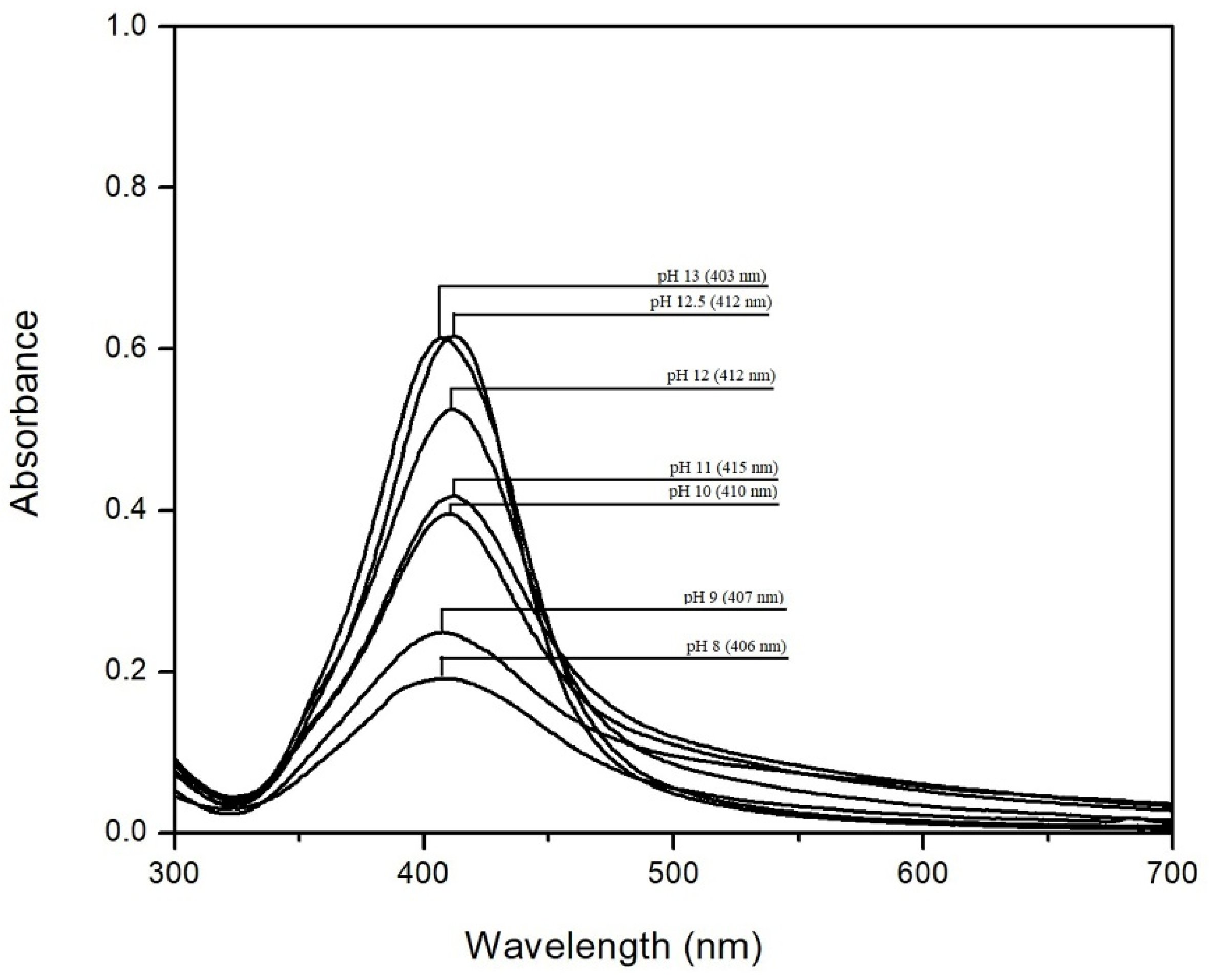
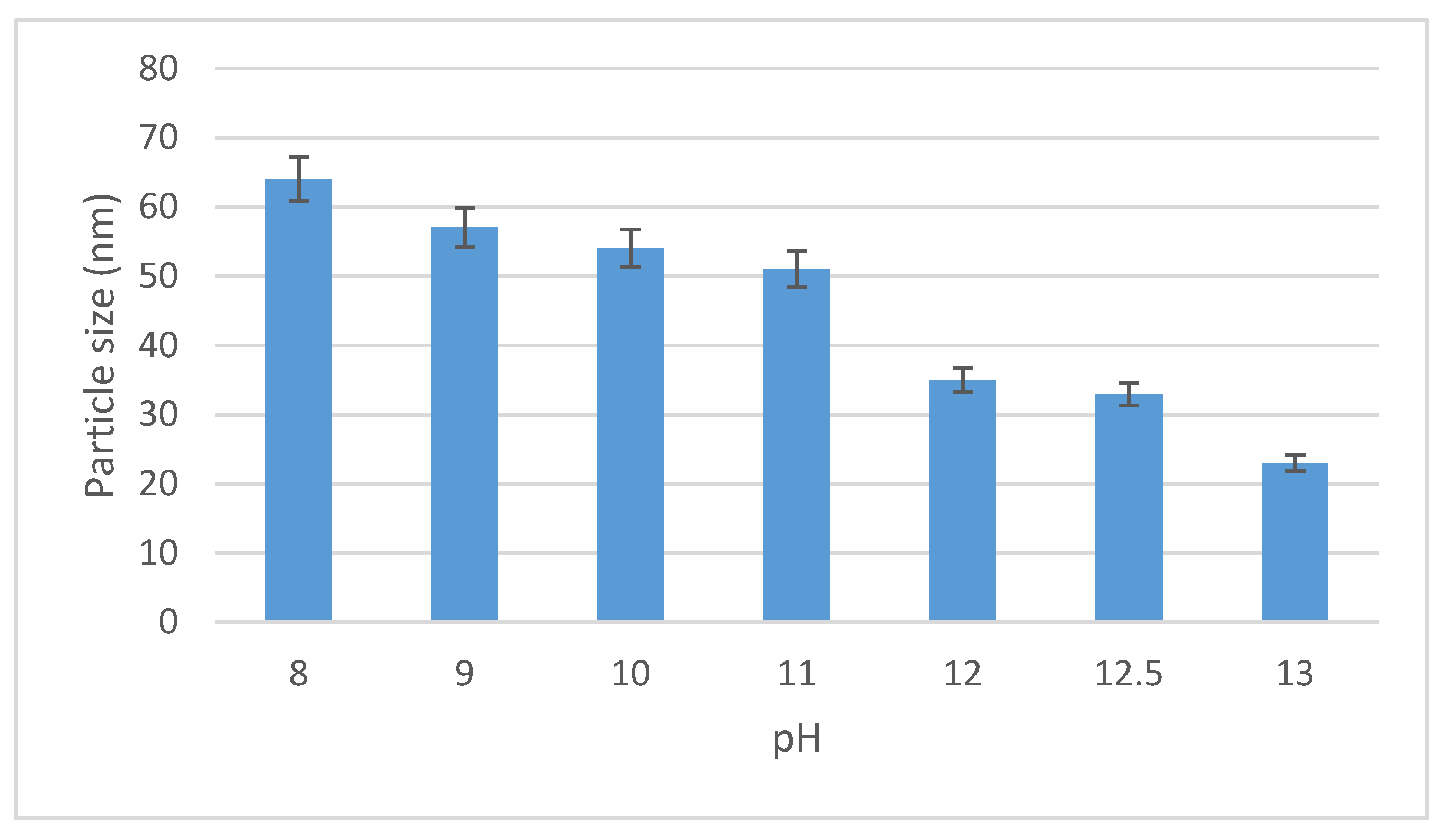
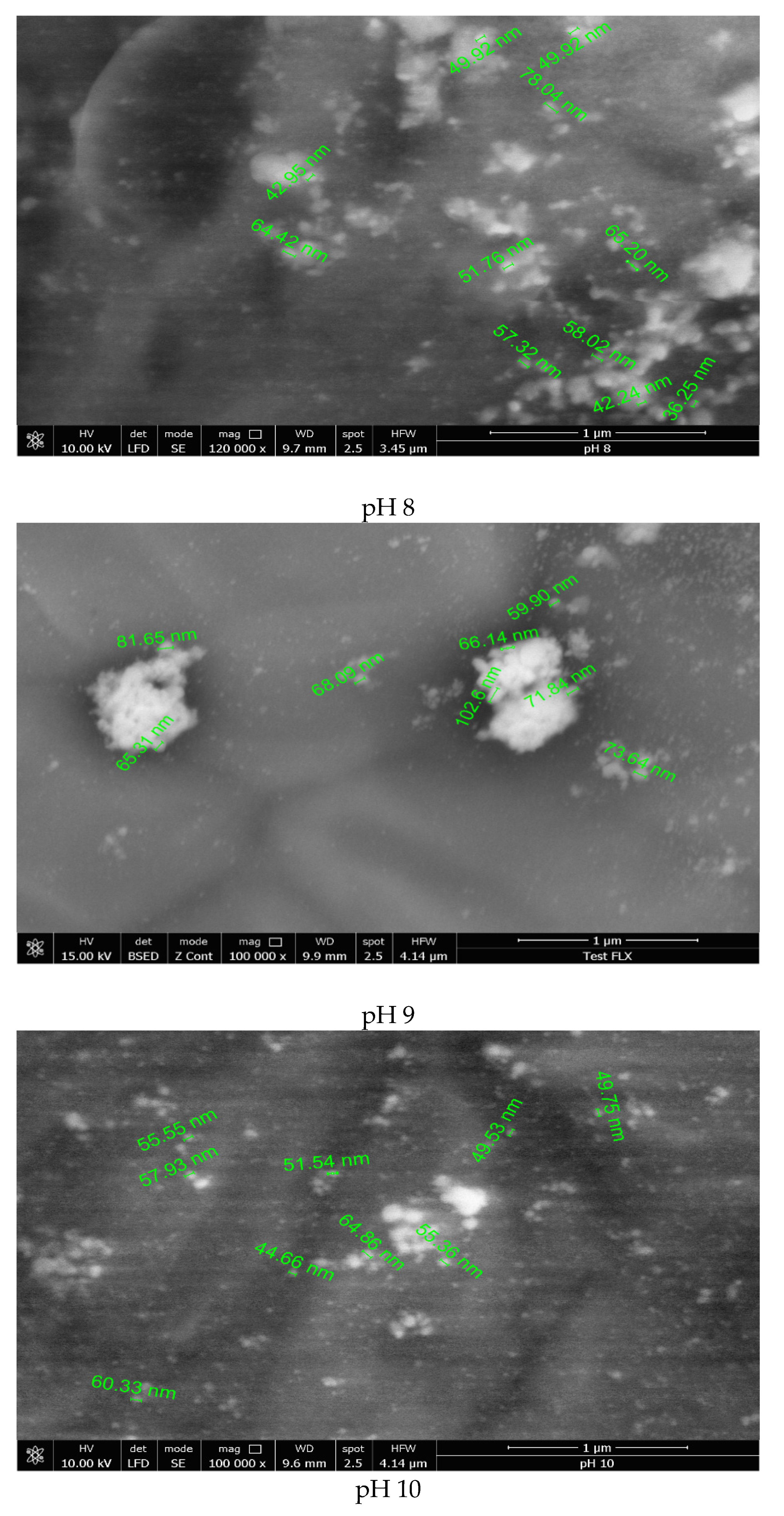
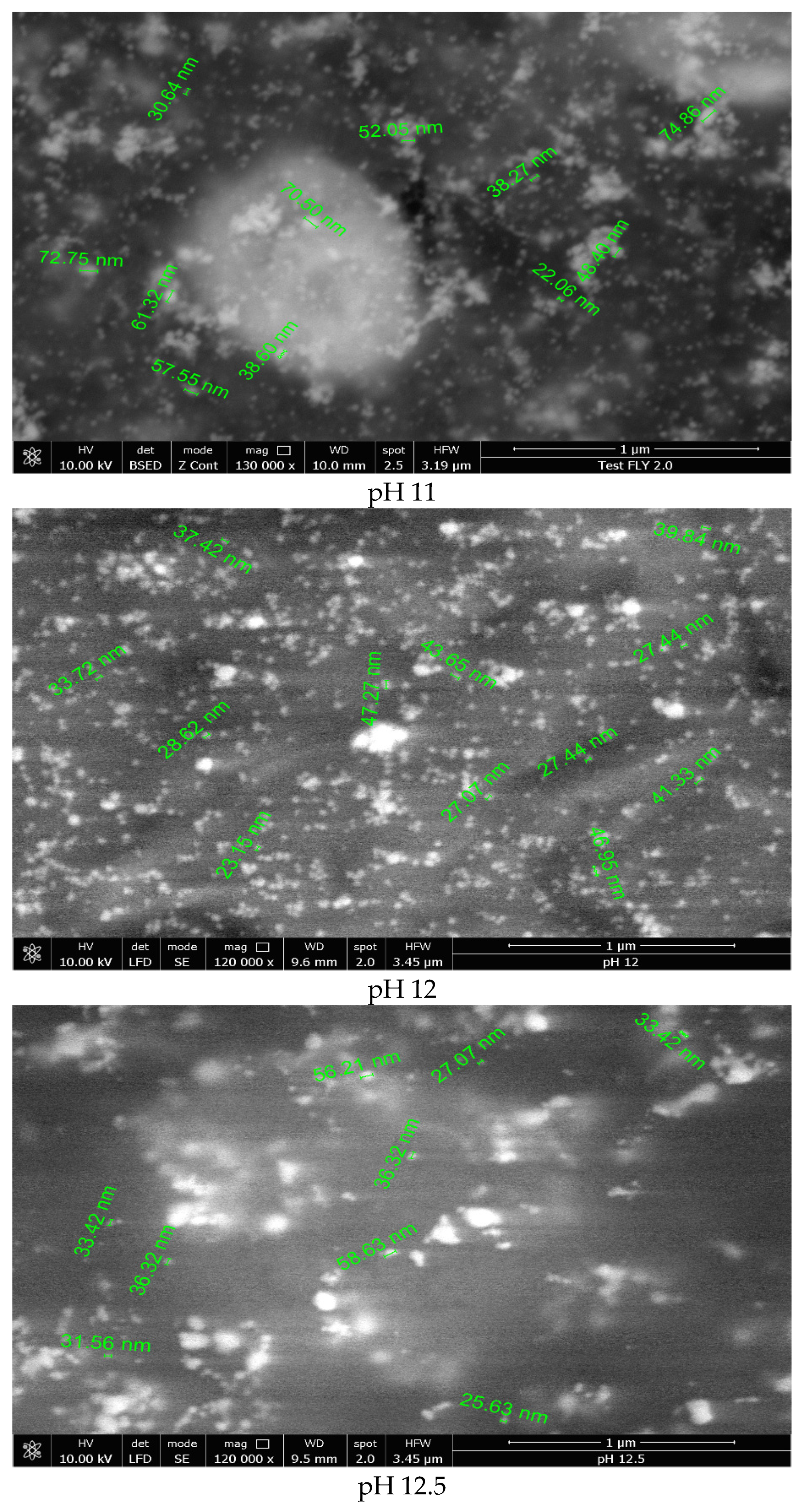
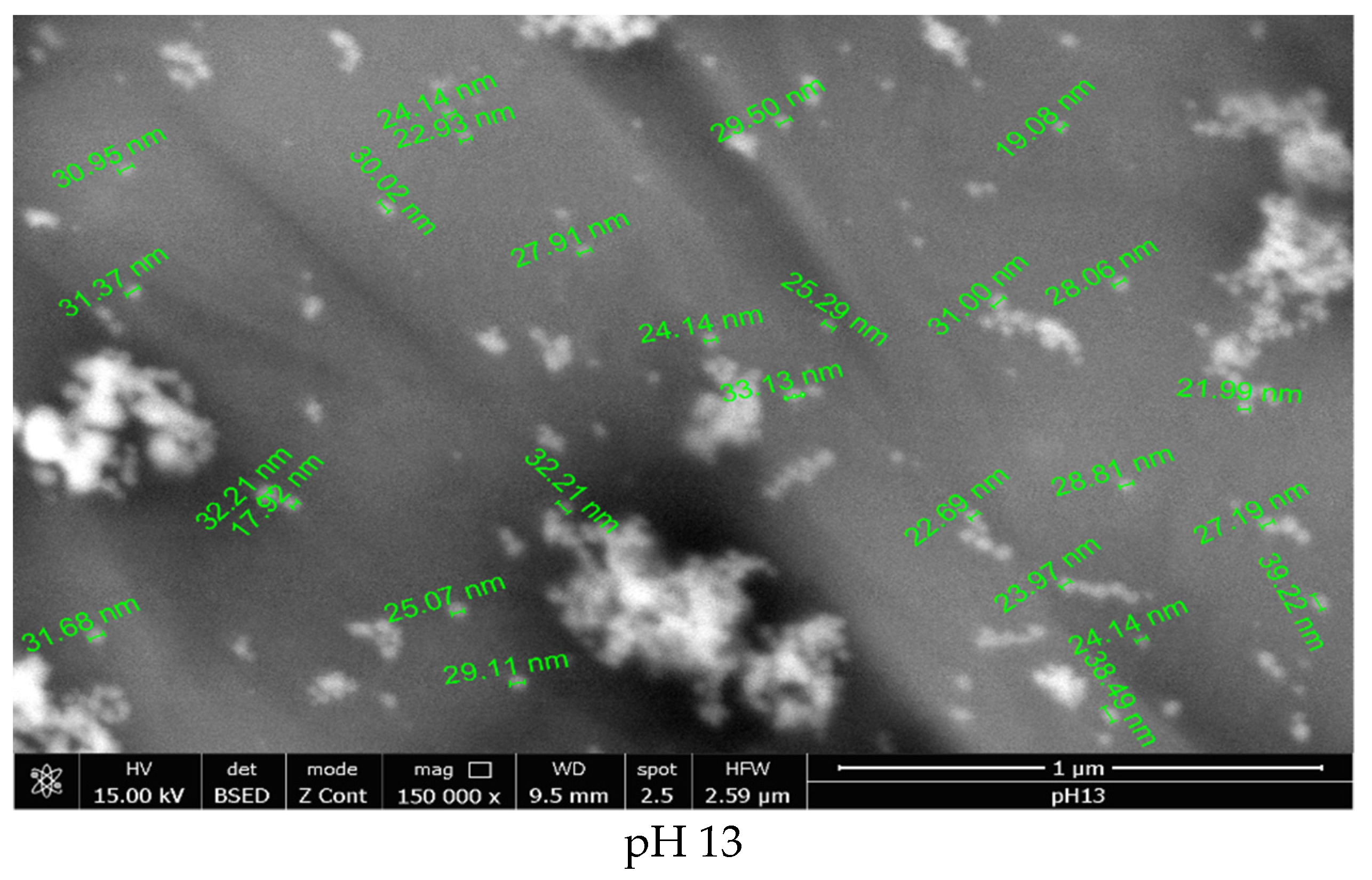
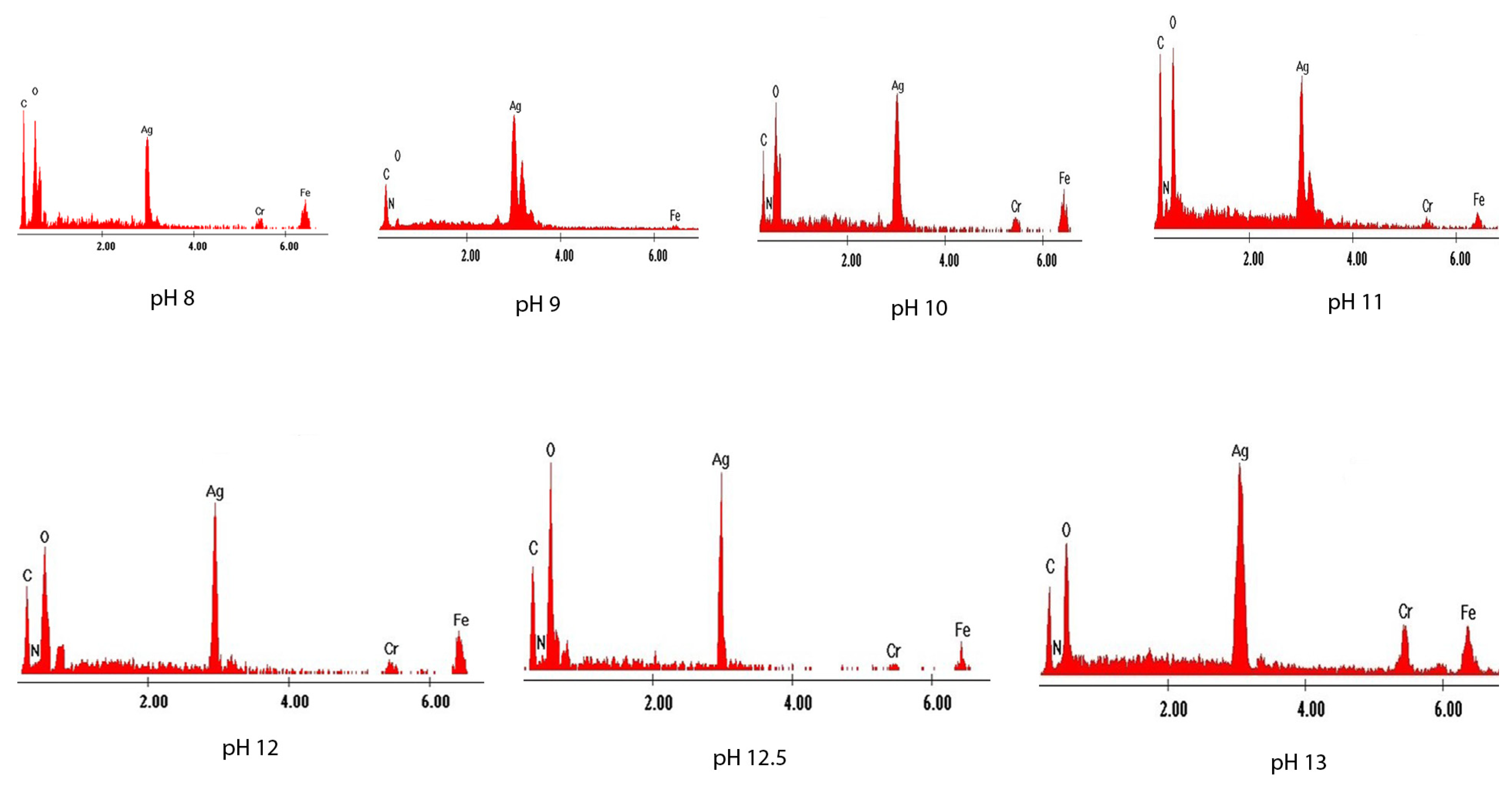
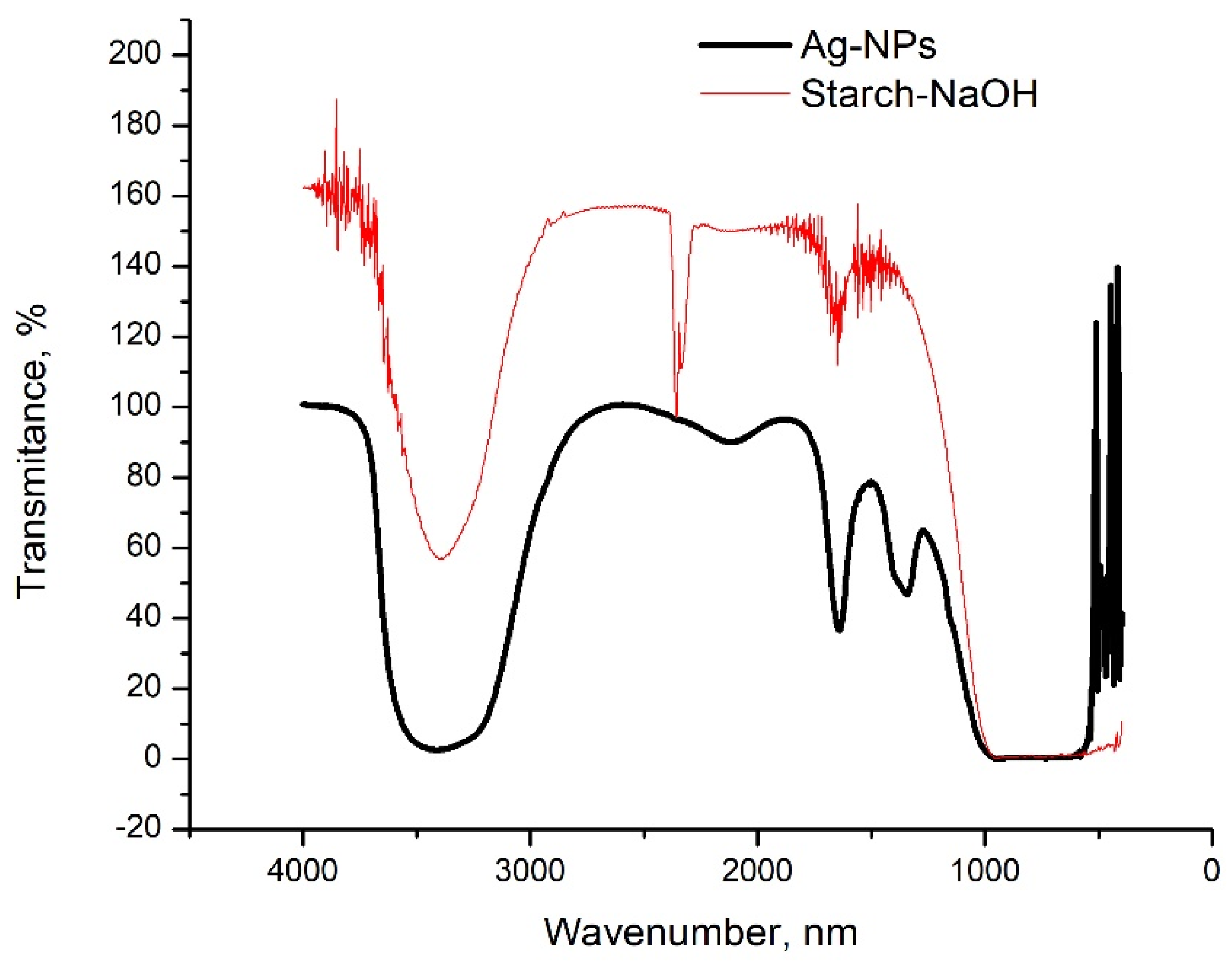
| pH | 8 | 9 | 10 | 11 | 12 | 12.5 | 13 |
|---|---|---|---|---|---|---|---|
| Zeta Potential, mV | 15.8 | 11.6 | 7.14 | −15.1 | −37.9 | −51.4 | −70.5 |
| Indicator Strains | Zone of Inhibition (mm) | Antibiotics Used in Positive Control Tests | |||
|---|---|---|---|---|---|
| AgNO3 Solution | Ag-NPs | Positive Control Test | Standard CLSI | ||
| Staphylococcus aureus ATCC 25923 | 11 | 19 | 26 | 23–29 | CEFOXITIN 30 µg |
| Pseudomonas aeruginosa ATCC 27853 | 9 | 16 | 27 | 25–33 | CIPROFLOXACIN 5 µg |
| Escherichia coli ATCC 25922 | 9 | 16 | 37 | 29–38 | CIPROFLOXACIN 5 µg |
| Streptococcus pneumoniae ATCC 49619 | 8 | 11 | 30 | 25–30 | ERITROMICINA 15 µg |
| Candida albicans ATCC 90028 | 10 | 20 | 22 | 18–27 | CASPOFUNGIN 5 µg |
| Clinically Isolated Strains | Zone of Inhibition (mm) | Antibiotics Used in Positive Control Test | |||
|---|---|---|---|---|---|
| AgNO3 Solution | Ag-NPs | Positive Control Test | Standard CLSI | ||
| Staphylococcus aureus Meticilina Sensibil (MSSA) | 10 | 19 | 24 | S ≥ 22 | CEFOXITIN 30 µg |
| Enterococcus faecalis | 10 | 18 | 23 | S ≥ 21 | CIPROFLOXACIN 5 µg |
| Escherichia coli | 9 | 18 | 34 | S ≥ 31 | CIPROFLOXACIN 5 µg |
| Klebsiella pneumoniae Ssp pneumoniae | 9 | 19 | 35 | S ≥ 31 | CIPROFLOXACIN 5 µg |
| Candida albicans | 8 | 10 | 18 | S ≥ 17 | CASPOFUNGIN 5 µg |
Publisher’s Note: MDPI stays neutral with regard to jurisdictional claims in published maps and institutional affiliations. |
© 2021 by the authors. Licensee MDPI, Basel, Switzerland. This article is an open access article distributed under the terms and conditions of the Creative Commons Attribution (CC BY) license (https://creativecommons.org/licenses/by/4.0/).
Share and Cite
Pascu, B.; Negrea, A.; Ciopec, M.; Duteanu, N.; Negrea, P.; Nemeş, N.S.; Seiman, C.; Marian, E.; Micle, O. A Green, Simple and Facile Way to Synthesize Silver Nanoparticles Using Soluble Starch. pH Studies and Antimicrobial Applications. Materials 2021, 14, 4765. https://doi.org/10.3390/ma14164765
Pascu B, Negrea A, Ciopec M, Duteanu N, Negrea P, Nemeş NS, Seiman C, Marian E, Micle O. A Green, Simple and Facile Way to Synthesize Silver Nanoparticles Using Soluble Starch. pH Studies and Antimicrobial Applications. Materials. 2021; 14(16):4765. https://doi.org/10.3390/ma14164765
Chicago/Turabian StylePascu, Bogdan, Adina Negrea, Mihaela Ciopec, Narcis Duteanu, Petru Negrea, Nicoleta Sorina Nemeş, Corina Seiman, Eleonora Marian, and Otilia Micle. 2021. "A Green, Simple and Facile Way to Synthesize Silver Nanoparticles Using Soluble Starch. pH Studies and Antimicrobial Applications" Materials 14, no. 16: 4765. https://doi.org/10.3390/ma14164765
APA StylePascu, B., Negrea, A., Ciopec, M., Duteanu, N., Negrea, P., Nemeş, N. S., Seiman, C., Marian, E., & Micle, O. (2021). A Green, Simple and Facile Way to Synthesize Silver Nanoparticles Using Soluble Starch. pH Studies and Antimicrobial Applications. Materials, 14(16), 4765. https://doi.org/10.3390/ma14164765









